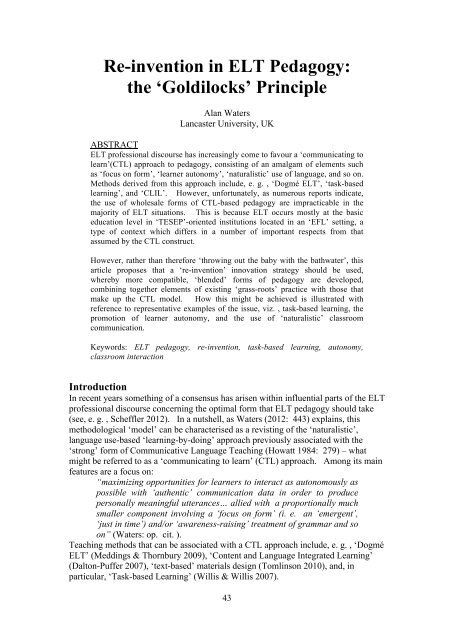RADICAL TEFL
2hqhXJd
2hqhXJd
Create successful ePaper yourself
Turn your PDF publications into a flip-book with our unique Google optimized e-Paper software.
Re-invention in ELT Pedagogy:<br />
the ‘Goldilocks’ Principle<br />
Alan Waters<br />
Lancaster University, UK<br />
ABSTRACT<br />
ELT professional discourse has increasingly come to favour a ‘communicating to<br />
learn’(CTL) approach to pedagogy, consisting of an amalgam of elements such<br />
as ‘focus on form’, ‘learner autonomy’, ‘naturalistic’ use of language, and so on.<br />
Methods derived from this approach include, e. g. , ‘Dogmé ELT’, ‘task-based<br />
learning’, and ‘CLIL’. However, unfortunately, as numerous reports indicate,<br />
the use of wholesale forms of CTL-based pedagogy are impracticable in the<br />
majority of ELT situations. This is because ELT occurs mostly at the basic<br />
education level in ‘TESEP’-oriented institutions located in an ‘EFL’ setting, a<br />
type of context which differs in a number of important respects from that<br />
assumed by the CTL construct.<br />
However, rather than therefore ‘throwing out the baby with the bathwater’, this<br />
article proposes that a ‘re-invention’ innovation strategy should be used,<br />
whereby more compatible, ‘blended’ forms of pedagogy are developed,<br />
combining together elements of existing ‘grass-roots’ practice with those that<br />
make up the CTL model. How this might be achieved is illustrated with<br />
reference to representative examples of the issue, viz. , task-based learning, the<br />
promotion of learner autonomy, and the use of ‘naturalistic’ classroom<br />
communication.<br />
Keywords: ELT pedagogy, re-invention, task-based learning, autonomy,<br />
classroom interaction<br />
Introduction<br />
In recent years something of a consensus has arisen within influential parts of the ELT<br />
professional discourse concerning the optimal form that ELT pedagogy should take<br />
(see, e. g. , Scheffler 2012). In a nutshell, as Waters (2012: 443) explains, this<br />
methodological ‘model’ can be characterised as a revisting of the ‘naturalistic’,<br />
language use-based ‘learning-by-doing’ approach previously associated with the<br />
‘strong’ form of Communicative Language Teaching (Howatt 1984: 279) – what<br />
might be referred to as a ‘communicating to learn’ (CTL) approach. Among its main<br />
features are a focus on:<br />
“maximizing opportunities for learners to interact as autonomously as<br />
possible with ‘authentic’ communication data in order to produce<br />
personally meaningful utterances… allied with a proportionally much<br />
smaller component involving a ‘focus on form’ (i. e. an ‘emergent’,<br />
‘just in time’) and/or ‘awareness-raising’ treatment of grammar and so<br />
on” (Waters: op. cit. ).<br />
Teaching methods that can be associated with a CTL approach include, e. g. , ‘Dogmé<br />
ELT’ (Meddings & Thornbury 2009), ‘Content and Language Integrated Learning’<br />
(Dalton-Puffer 2007), ‘text-based’ materials design (Tomlinson 2010), and, in<br />
particular, ‘Task-based Learning’ (Willis & Willis 2007).<br />
43


